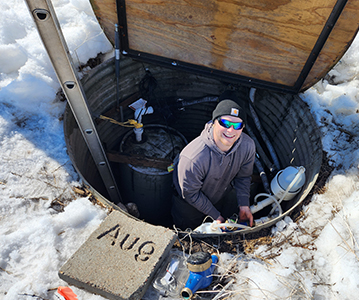by Zac Aanerud
Corn, a staple crop in Minnesota, plays a crucial role in the state's economy and the lives of its residents. However, achieving profitability while maintaining environmental responsibility can be a challenge, especially when it comes to nitrogen (N) usage. N is an essential nutrient for plant growth, and farmers often use it as fertilizer to boost crop productivity. But excessive N use can be financially burdensome and detrimental to the environment.

To address these concerns, our study conducted at the Southwest Research Outreach Center in Lamberton, Minnesota, aims to find the most corn-profitable and environmentally responsible N rate. By comprehensively evaluating different N rates, we hope to strike a sustainable balance between corn grain yield, profitability, and N losses.
Beginning in the 2021 growing season, we applied five N rates in increments of 80 lb/ac (0, 80, 160, 240, 320 lb N/ac) in a continuous corn cropping system. Our pre-plant fertilizer was environmentally smart N (ESN), a polymer-coated urea, which was broadcasted and incorporated with tillage. The remaining N was applied as a broadcast application about 35 days after planting using urea with a urease inhibitor to minimize volatilization losses from the fertilizer left on the soil surface. These are considered best management practices (BMPs) to minimize losses through nitrate leaching and gas emissions such as nitrous oxide and ammonia, which contribute to environmental degradation, air pollution, and climate change.
We know that plants take in N throughout the growing season, but we also know that N loss can happen, especially when there is a lot of precipitation. For these reasons we collected various agronomic measurements including soil, plant, grain, and canopy data throughout the entire growing season to understand where all the N is going.
Furthermore, our study focused on measuring environmental responses to N. Continuous automated sampling equipment allowed us to monitor nitrate leaching from each plot. A portable high accuracy analyzer helped us measure nitrous oxide emissions. Ammonia emissions were also collected using a semi-static chamber methodology. By analyzing these environmental factors along with agronomic factors, we gain valuable insights into the impact of different N rates on the environment when applied using BMPs.
Utilizing regression analysis, we developed response curves to N rate, enabling us to find the “sweet spot” where grain production is maximized while minimizing N loss. We assessed the cost-benefit relationship between these variables, allowing us to determine the optimum N rate. By optimizing different parameters, we explored various scenarios to further fine-tune our findings.
Our study aims at providing practical knowledge for sustainable corn production in Minnesota. By identifying the optimal N rate, we can minimize N loss, reduce environmental degradation, and maintain corn profitability. Our goal is to translate the wealth of data and insights we have gathered into actionable information that benefits Minnesota corn growers and society. As we process the results from our ongoing field season, we are excited to uncover even more findings that will shape the future of corn farming in Minnesota.
In conclusion, achieving a balance between corn profitability and environmental responsibility is key to a sustainable future. Through our research, we strive to empower farmers with the tools and knowledge necessary to make informed decisions, benefiting both their economic well-being and the environment. By optimizing N usage, we can ensure a prosperous future for corn production in Minnesota, safeguarding the livelihoods of farmers and preserving the beauty of our natural surroundings.